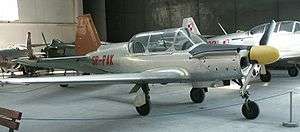PZL M-4 Tarpan
| M-4 Tarpan | |
|---|---|
 | |
| M-4P in the Polish Aviation Museum | |
| Role | Trainer aircraft |
| Manufacturer | PZL-Mielec |
| First flight | 7 September 1961 |
| Status | Prototype |
| Number built | 2 prototypes |
|
| |
PZL M-4 Tarpan (also tarpan) was a Polish trainer and sports aircraft prototype of the 1960s, designed in WSK-Mielec.
Design and development
The M-4 was designed for a demand of the Polish Aero Club, for a trainer plane with a retractable tricycle landing gear. It was based on an earlier project PZL M-2. The basic variant was to be M-4P, for navigation training. The works started in 1958, and the first prototype was built in 1960. Due to a long engine development, it first flew on September 7, 1961 (registration SP-PAW). Trials showed, that the weight was much higher, than estimated (890 kg instead of 748 kg), which demanded changes in design. In July 1964 the second prototype was flown (registration SP-PAK).
Flight characteristics and stability of the M-4 were estimated as good, it also fit to aerobatics and rally flying. The cab offered an excellent view for the crew and the plane was overall quite successful. However, because of too high price, the Polish Aero Club decided not to order the plane and the production has not started. A development of the flat engine PZL WN-6 was troublesome and was finally canceled at that time as well.
Operational history
In 1965 both prototypes were converted to single seater aerobatics variant (in some sources known as the M-4A) by removing front cab equipment. It was planned to use them in World Aerobatics Championship in 1966 in Moscow, but they have not finished full homologation trials and the idea was abandoned. They were not used in this role much.
Operators
- Aeroklub Polski operated second prototype in Mielec.
Survivors
The second M-4 prototype (SP-PAK) is preserved in the Polish Aviation Museum in Kraków, from 1971.
Specifications
Description
Metal construction low-wing monoplane, conventional in layout, metal covered. Semi-monocoque fuselage. Trapezoid two-spar wings. Crew of two, sitting in tandem, under a common canopy, with double controls (student in front, instructor in the rear). Retractable tricycle landing gear. Two-blade wooden propeller of variable pitch (diameter 2 m). Fuel tanks in wings (140 l).
General characteristics
- Crew: 1, instructor
- Capacity: 1, student
- Length: 7.35 m (24 ft 1¼in)
- Wingspan: 8.85 m (29 ft 0⅜in)
- Height: 2.61 m (8 ft 6¾ in)
- Wing area: 11.79 m² (127 ft²)
- Empty weight: 888 kg (1,954 lb)
- Loaded weight: 1,200 kg (2,640 lb)
- Powerplant: 1 × WN-6B air-cooled 6-cylinder boxer engine, 143 kW (195 hp)
Performance
- Maximum speed: 300 km/h (162 kn, 186 mph)
- Cruise speed: 260 km/h (140 kn, 161 mph)
- Stall speed: <101 km/h (55 kn, 63 mph)
- Range: 750 km (405 nmi, 466 mi)
- Service ceiling: 4400 m (14,400 ft)
- Rate of climb: 4.2 m/s (830 ft/min)
- Wing loading: 102 kg/m² (20.8 lb/ft²)
See also
- Aircraft of comparable role, configuration and era
References
| Wikimedia Commons has media related to PZL M-4 Tarpan. |
- Janusz Babiejczuk, Jerzy Grzegorzewski: Polski przemysł lotniczy 1945-1973, Warsaw 1973 (Polish language)
- Marian Krzyżan: Samoloty w muzeach polskich, WKiŁ, Warsaw 1983, ISBN 83-206-0432-X (Polish language)